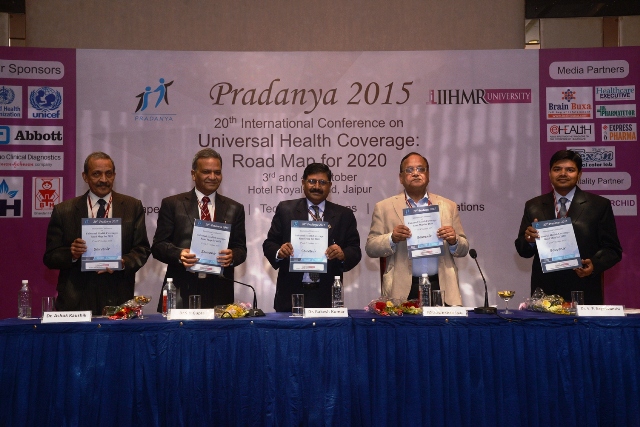IIHMR University organises 20th Annual Conference - Pradanya 2015
Public Expenditure on Health to Be Stepped Up From 1.2% of GDP Today to At Least 3% of GDP By 2022
India, October, 2015: India's globally recognised and leading healthcare research institutions, IIHMR University, today inaugurated its 20th Annual Conference - Pradanya 2015. This most awaited two days' conference was inaugurated by the Chief Guest, Dr. Rakesh Kumar, Joint Secretary, Ministry of Health and Family Welfare (MoHFW), Government of India in presence of Dr. S. D. Gupta, President of IIHMR University and other dignitaries.
.jpg)
Till the 20th century Universal Health Coverage (UHC) was challenge and could reach to high-income countries only. Lower- and middle-income countries were struggling earlier for UHC but since last two decades they could fruitfully reformed to make quality healthcare which is at par with high-income countries. Countries as diverse as Brazil, Ghana, Mexico, Rwanda, Turkey and Thailand have made tremendous progress toward universal health coverage in recent years. Now the most populated countries, India and China, are also pursuing universal health coverage, and over 80 countries have also asked for implementation assistance from WHO.
Over 500 participants attended the conference and 1000s of professionals from over 10 countries watched live conference through webcast. Following the WHO guidelines on UHC, various speakers and panelists shared their concerns and opinions on how to increase access, affordability and availability in healthcare; what is required for drug innovation and patent regime; How to reduce cost of Healthcare and Financing; Role of operations management in healthcare systems and Quality and Safety in Healthcare.
.jpg)
.jpg)
Addressing the conference, Dr. Rakesh Kumar, Joint Secretary, MoHFW, GOI said, "Intention of UHC implementation in India is aimed for availing latest health practices to the extent low-income of the population of the country that are unable to afford. Thereby we are also expecting to cover UHC to the 80% population in the country. Government had started a pilot project on covering UHC programme in 27 districts where in 20 disease are covered under the categories of primary healthcare, secondary healthcare and Tertiary Healthcare. Central and State government is currently taking care of the primary healthcare which includes women fertility, pregnancy and delivery, child healthcare etc. But for secondary and Tertiary healthcare, out of pocket expenditure gets increased and a person requires strong healthcare finance to use the private healthcare facilities. Currently government spending on primary and secondary healthcare is nearly 1.2% of country's GDP, which is required to be increased by committed partnership of private healthcare sector. "

Dr. S D Gupta, President of IIHMR University said, "Country's 70% healthcare spending is made by individuals and government bears rest of the cost. To strengthen the health system and bear the complete healthcare cost of the country, including the poor class people, government requires lot of financing which is difficult at this stage. Not only the healthcare financing but the scarcity of trained and professional human resource is required to be improved for UHC mission. "
As recommended in the High Expert Group Report on Universal Health Coverage for India, financing the proposed UHC system will require public expenditures on health to be stepped up from around 1.2% of GDP today to at least 2.5% by the end of the 12th plan, and to at least 3% of GDP by 2022. With the assumption of current level of combined public and private spending of around 4.5% of GDP, this will result in a five-fold increase in real per capita health expenditures by the government Rs. 650-700 in 2011-12 to Rs. 3400-3500 by 2021-22. With the help of this, there will be a corresponding decline in real private out-of-pocket expenditures from around Rs. 1800-1850 in 2011-12 to Rs. 1700-1750 by 2021-22. With this estimate, the increased public expenditures will lead to a sharp decline in the proportion of private out-of-pocket spending on health - from around 67% today to around 33% by 2022.
The Indian Government plans to fill critical gaps in infrastructure and manpower planning in recognition of fresh challenges being posed due to increasing migration from rural to urban areas. The approach under NHM focus on, inter-alia, augmentation of human resources; strengthening of health infrastructure; flexible financing and enhanced allocation of funds to health care facilities; provisioning of health service delivery in unserved and underserved areas in both rural and urban areas; decentralized planning, initiatives to improve maternal and child health; providing financial assistance to States for selection and training of Accredited Social Health Activist (ASHA) who act as a link between community and health care facilities; prevention and control of vector borne diseases as well as of non-communicable diseases.
The programs and initiatives undertaken by the Department of Health and Family Welfare, like Janani Shishu Suraksha Karyakram (JSSK), Name based Mother and Child Tracking System (MCTS), delivery of contraceptives to doorsteps, Menstrual Hygiene Scheme, Weekly Iron folic Acid Supplementation Programme, School Health Programme and Reproductive Maternal New born Child Health+A (RMNCH+A) services, etc would be taken forward in greater zeal.
To address critical gaps in human resources availability in the public health delivery system expansion of medical schools /nursing colleges / paramedical institution would continue to receive priority. It is also recommended in the High Expert Group Report on Universal Health Coverage for India, that by 2022 India should open 187 new medical colleges, 58 new nursing colleges, 382 new nursing schools and 232 new ANM Schools. Government has taken several initiatives to augment human resources in the health sector focusing on healthcare management, medical education, nursing education, paramedical education, etc.
~ : END : ~
